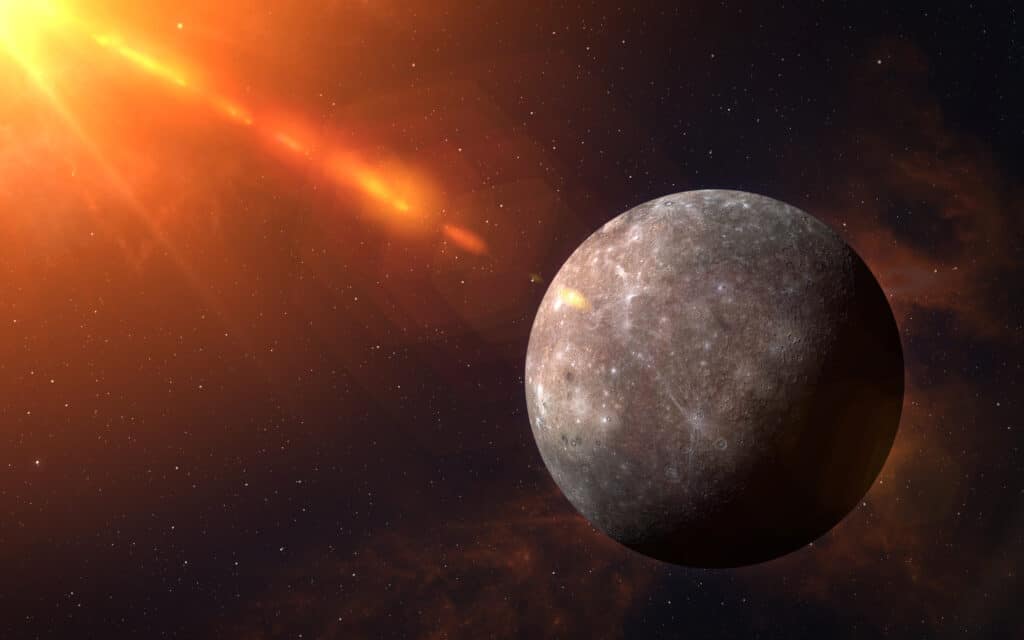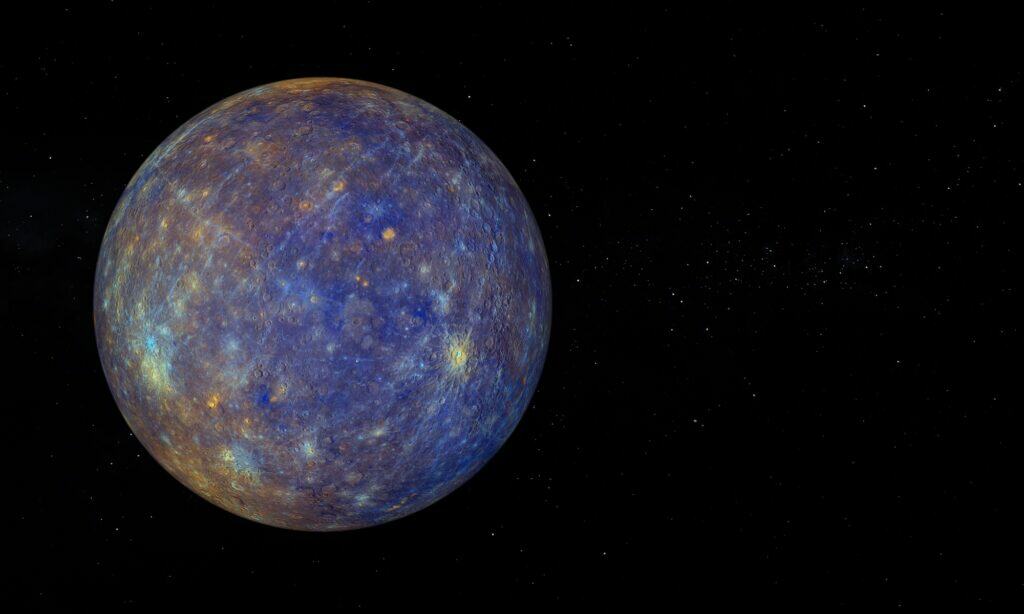If you love basking in the sun, you might be interested in maximizing your exposure to it. However, you probably know that going to Mercury, the planet closest to the Sun, is not a good idea.
Mercury, the smallest planet in the solar system, actually presents an environment that would be pretty similar to the Moon, although much hotter during the daytime.
If humans can somehow find a way to inhabit this planet, it could lead to all sorts of questions about what life would be like on Mercury. You might be interested, for instance, in knowing how much you’d weigh on Mercury.
How Much Would You Weigh on Mercury?

People and objects on Mercury would weigh about 38% of their weight on Earth.
©iStock.com/FlashMyPixel
Although humans would need a lot of protection to deal with the extreme temperatures and atmosphere of Mercury, it does have a solid surface on which you could land, like Earth.
If you were to land on Mercury, you would weigh 38% of what you do on this planet. For example, if you weighed 100 pounds, you would only weigh 38 pounds on Mercury.
The following is a table showing what people of different masses would weigh if they were to go to Mercury (rounded to the nearest whole number):
| Weight on Earth | Weight on Mercury |
|---|---|
| 100 pounds | 38 pounds |
| 105 pounds | 40 pounds |
| 110 pounds | 42 pounds |
| 115 pounds | 44 pounds |
| 120 pounds | 46 pounds |
| 125 pounds | 48 pounds |
| 130 pounds | 49 pounds |
| 135 pounds | 51 pounds |
| 140 pounds | 53 pounds |
| 145 pounds | 55 pounds |
| 150 pounds | 57 pounds |
| 155 pounds | 59 pounds |
| 160 pounds | 61 pounds |
| 165 pounds | 63 pounds |
| 170 pounds | 65 pounds |
| 175 pounds | 67 pounds |
| 180 pounds | 68 pounds |
| 185 pounds | 70 pounds |
| 190 pounds | 72 pounds |
| 195 pounds | 74 pounds |
| 200 pounds | 76 pounds |
| 205 pounds | 78 pounds |
| 210 pounds | 80 pounds |
| 215 pounds | 82 pounds |
| 220 pounds | 84 pounds |
| 225 pounds | 86 pounds |
| 230 pounds | 87 pounds |
| 235 pounds | 89 pounds |
| 240 pounds | 91 pounds |
How Is Weight on Mercury Determined?
If you want to know why you would be so much lighter on Mercury than you would be on Earth, it’s a good idea to familiarize yourself with the difference between mass and weight. Your mass tells you how much matter is contained in your body. In contrast, your weight is a measure of the attraction that exists between your body and the center of the planet.
There is an equation that you can use to figure out how much an object would weigh on any planet, derived by Sir Isaac Newton. This equation is F=Mm/r2 (where M is the mass of the planet, m is the mass of the object, and r is the distance between the object and the planet’s center).
Mercury has a similar gravitational pull to Mars; on either one of these planets, people and objects would weigh 38% of what they do on Earth. However, they are not the same size.
Although Mars is the second smallest planet in the solar system after Mercury, Mars has almost twice the mass of Mercury. The radius of Mars is about 130% that of Mercury. Plugging these factors into Newton’s equation, the gravitational pull comes out to be nearly the same.
Earth has the highest density of any planet, but Mercury is a close second. Mercury has a mass that is only 5.5% the mass of Earth, with the diameter and radius being about 38% of Earth’s.
When you plug both sets of numbers into the equation and consider the difference in both mass and volume (volume is defined by the radius), it makes sense that you would weigh much less on Mercury.
What Would Other Things Weigh on Mercury?
Any person or object that could possibly come to your mind would weigh 38% of what it does on Earth if it were to be transported to Mercury.
If you have a mid-size car, for example, it probably weighs between 3,000 and 3,500 pounds. If you were to send it to Mercury, it would now only weigh 1,140 to 1,330 pounds. A 22-ounce standard basketball would now weigh a very light 8.3 ounces, and an 8.6-ounce gallon of milk would be only 3.3 ounces on the surface of Mercury.
All you need to do to figure out how much something or someone would weigh on Mercury is to multiply its weight as you know it by a factor of 0.38.
How Much Does Mercury Weigh?

Mercury has a mass of 3.285 × 10
23kilograms, or 7.278 × 10
23pounds, which is about 5.5% of the mass of Earth.
©iStock.com/buradaki
The mass of Mercury is about 3.285 × 1023 kilograms, or 7.278 × 1023 pounds, which is about 5.5% of Earth’s mass. Since the density is very close to that of Earth (98% of Earth’s density), Mercury has just over 5.5% of Earth’s volume.
Mercury is thought to have a crust, mantle, and core, just like Earth. Scientists believe that the inner core of Mercury is solid, made up primarily of iron with some silica rocks. The outer core is molten and made of iron. The core of Mercury contains more iron than any other major planet.
Iron makes up about 70% of the total weight of the planet, and silicate materials make up the other 30%. This presents a contrast to Earth, which is primarily made up of silicate materials.
Mercury’s mantle makes up the space between the core and the level approximately 311 miles (500 kilometers) beneath the planet’s surface. Silicates and other metals, including additional iron, make up this mantle. Scientists believe that about 11% of the original mantle of the planet has been converted to rocks that are now a part of the crust.
There are many volcanoes on the surface of Mercury. The volcanic matter has left vents in the crust that have proven the presence of silica and iron in Mercury’s inner core. The core makes up about 85% of the radius of the planet, with the outer shell only being about 250 miles (400 kilometers) thick.
Could Any Life Survive on Mercury?

Due to extreme temperatures, intense solar radiation, and a lack of atmosphere, scientists do not believe life on Mercury could exist at this time.
©HAKAN AKIRMAK VISUALS/Shutterstock.com
Scientists do not believe that life as we know it could exist on Mercury, due to extreme temperatures, solar radiation, and a lack of atmosphere.
Many believe that Mercury is the hottest planet in the solar system. While it can be extremely hot, Venus, despite being a little bit further from the Sun, is actually hotter because of its ability to retain heat from the Sun in its atmosphere.
Mercury has a very thin and non-protective atmosphere. Scientists would say that the atmosphere is essentially a vacuum; it’s referred to as an exosphere. Mercury is constantly losing atoms from its exosphere, mostly hydrogen, oxygen, and sodium, to outer space. Solar winds randomly replenish these atoms.
Despite Mercury’s close proximity to the Sun, without an insulating atmosphere, it can’t hold on to the warmth of the Sun at night. Because of this, it isn’t a consistently hot planet.
The surprising truth is that temperatures can be at both extremes on the planet Mercury. During the days, the surface temperature can go up to 800° Fahrenheit, or 430° Celsius. However, at night, it can go all the way down to -290° Fahrenheit, or -180° Celsius.
This is not to say that life on Mercury would be absolutely impossible. Scientists recently found water ice at the poles of Mercury. Additionally, a team found potential evidence for the presence of the chemical building blocks of life under Mercury’s surface. While there is still no evidence of life, it appears that the raw materials for it are there, and there is no way to say it will never be possible.
The photo featured at the top of this post is © HAKAN AKIRMAK VISUALS/Shutterstock.com
Thank you for reading! Have some feedback for us? Contact the AZ Animals editorial team.






